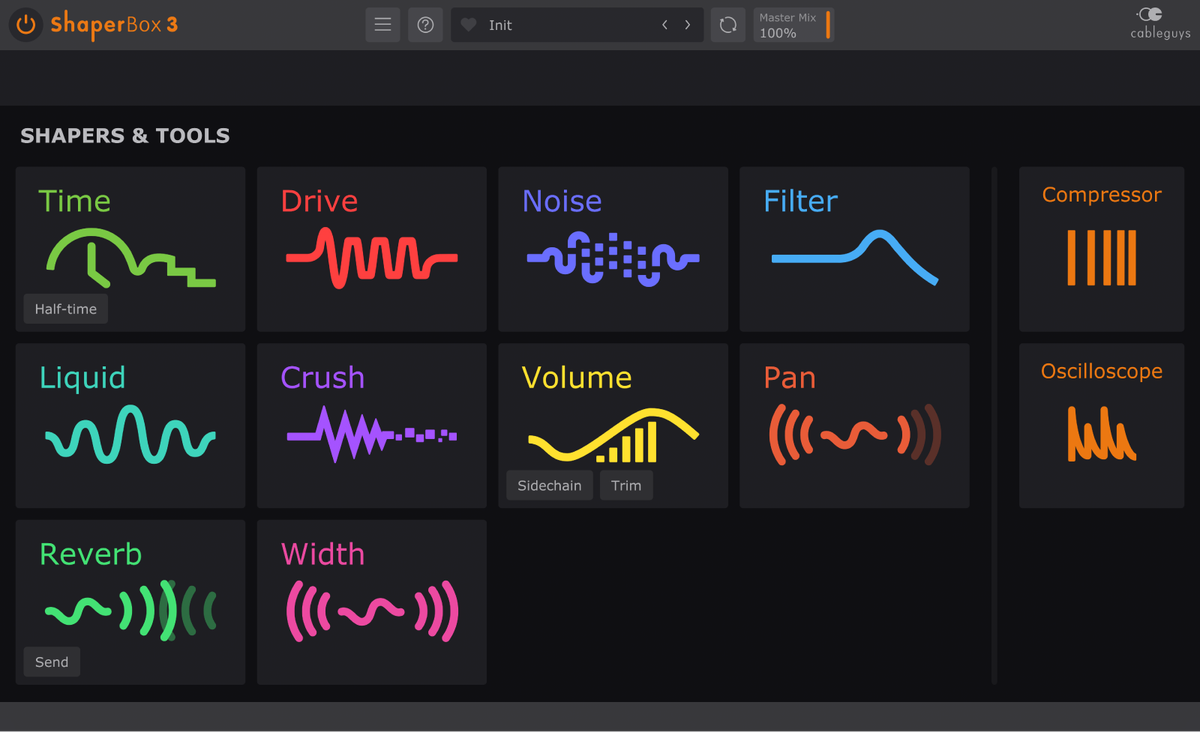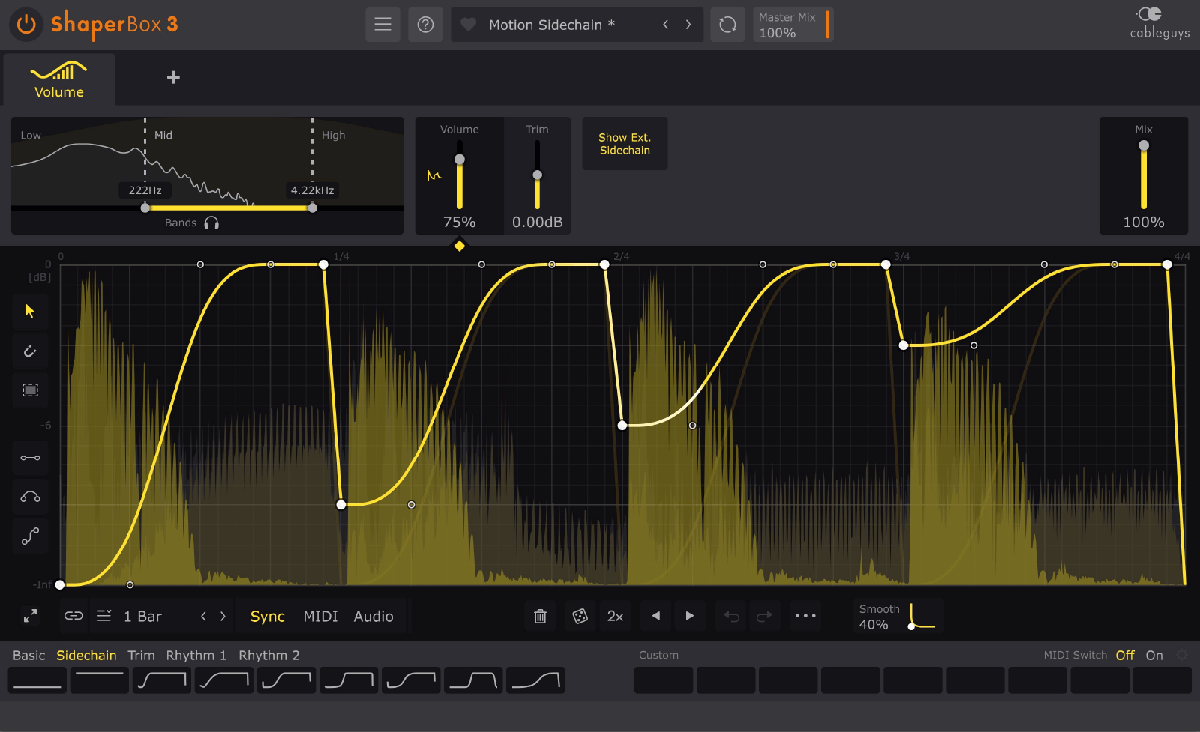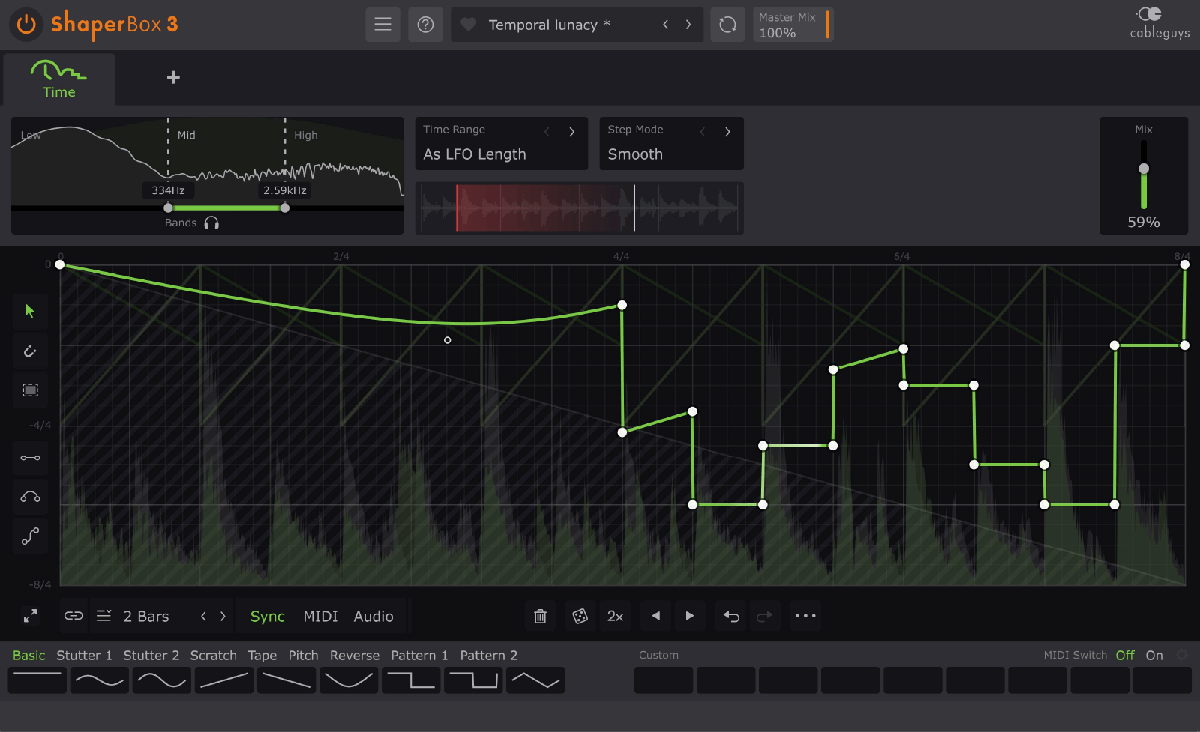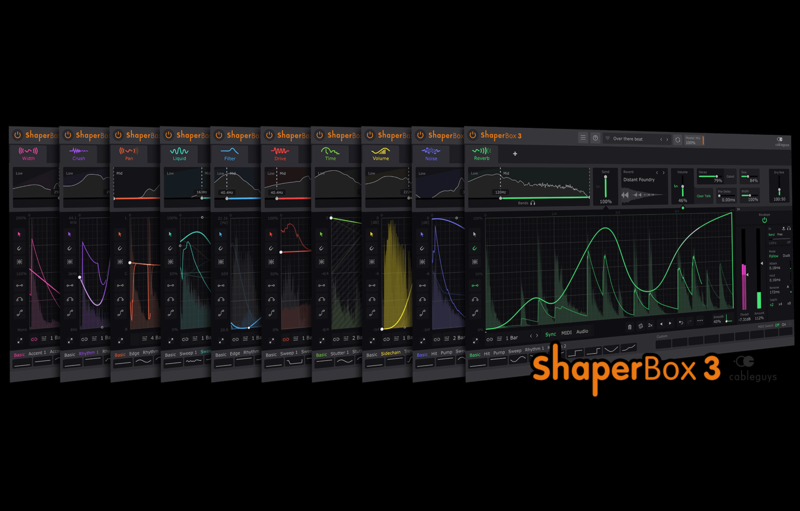Using ShaperBox Plugin
Master modulation and audio shaping with ShaperBox 3
Introduction to ShaperBox
ShaperBox 3 is a powerful multi-effect plugin by Cableguys that has become an essential tool for modern music producers. It combines ten dynamic shaper modules in one plugin, allowing for creative modulation, rhythmic effects, and advanced sound design.

Why ShaperBox is Useful for Ableton Producers
ShaperBox 3 integrates seamlessly with Ableton Live, providing capabilities that extend beyond Ableton's native devices:
- Precise Rhythmic Control - Create complex modulation patterns that sync perfectly to your project tempo
- Creative Sound Design - Transform ordinary sounds into dynamic, evolving textures
- Workflow Efficiency - Combine multiple effects in one interface rather than chaining multiple devices
- Unique Effects - Achieve results that would be difficult or impossible with standard Ableton devices
- CPU Efficiency - Get multiple effects in a single plugin instance, reducing CPU load
Different Modules within ShaperBox
ShaperBox 3 includes ten specialized modules, each focusing on a different aspect of sound manipulation:
- VolumeShaper - Modulate volume for sidechain-like effects, tremolo, and gating
- TimeShaper - Manipulate time and pitch for glitch effects, tape stops, and stutters
- FilterShaper - Create dynamic filter sweeps and frequency modulation
- PanShaper - Control stereo positioning for spatial movement
- WidthShaper - Modulate stereo width for expanding and contracting the stereo field
- CrushShaper - Add bit-crushing and sample rate reduction effects
- DriveShaper - Apply dynamic distortion and saturation
- NoiseShaper - Add rhythmic noise textures and atmospheres
- LiquidShaper - Create fluid, morphing filter effects
- ReverbShaper - Apply dynamic, rhythmic reverb effects
Pro Tip
You can use multiple modules simultaneously within a single instance of ShaperBox 3. This allows you to create complex effect chains that all follow the same rhythmic pattern or respond to the same sidechain input.
Core Features and Functionality
Understanding the core features of ShaperBox 3 is essential for harnessing its full potential in your productions.
The Waveform Editor
At the heart of ShaperBox is its powerful waveform editor, which allows you to draw modulation shapes with precision:
- Grid Settings - Sync to project tempo with adjustable grid divisions
- Point Editing - Add, move, and delete points to create custom shapes
- Curve Types - Choose between linear, curved, stepped, and smooth transitions
- Preset Shapes - Access common shapes like sine, square, triangle, and saw waves
- Multi-point Selection - Edit multiple points simultaneously for complex shape creation

VolumeShaper Module
The VolumeShaper module is one of the most commonly used modules in ShaperBox 3:
- Dynamic Volume Control - Create rhythmic volume patterns for pumping effects
- Sidechain Simulation - Achieve precise sidechain-like effects without actual sidechaining
- Tremolo Effects - Create classic and complex tremolo patterns
- Gating - Apply rhythmic gating effects for creative chopping
TimeShaper Module
TimeShaper allows for manipulation of time and pitch, creating unique glitch and stutter effects:
- Time Manipulation - Create tape stops, stutters, and glitches
- Pitch Effects - Generate pitch shifts and modulations
- Buffer Controls - Adjust how audio is captured and played back
- Reverse Effects - Create sections of reversed audio

ReverbShaper Module
The ReverbShaper module adds dynamic reverb effects with precise control:
- 120+ Reverb Spaces - Choose from a wide variety of reverb types
- Frequency Band Control - Apply reverb to specific frequency ranges
- Dynamic Modulation - Create rhythmic reverb effects
- Custom Impulse Responses - Import your own impulse responses

Advanced Features
ShaperBox 3 includes several advanced features that expand its capabilities:
- Multiband Processing - Apply effects to specific frequency bands
- External Sidechain - Trigger modulation from external audio sources
- MIDI Control - Map parameters to MIDI controllers for live manipulation
- Audio Rate Modulation - Create complex modulation at audio rates
- Preset Browser - Access and organize a library of presets
Performance Consideration
While ShaperBox 3 is relatively CPU-efficient, using multiple instances with complex modulation shapes and multiple active modules can increase CPU usage. Consider freezing or bouncing tracks with CPU-intensive settings when working on large projects.
Creative Techniques
ShaperBox 3 opens up a world of creative possibilities for sound design and mixing. Here are some innovative ways to use it in your Ableton productions:
Rhythmic Volume Modulation
-
Advanced Sidechain Effects
Use VolumeShaper to create precise, customizable sidechain pumping effects on bass, pads, or entire mix groups. Draw custom curves that go beyond simple ducking for more musical results.
-
Rhythmic Gating
Create staccato rhythmic patterns by drawing sharp on/off volume shapes. Apply to sustained sounds like pads or vocals to transform them into rhythmic elements.
-
Dynamic Transitions
Automate the Mix knob to gradually introduce volume modulation during transitions between song sections, creating build-ups and breakdowns.
Time and Pitch Manipulation
-
Tape Stop Effects
Use TimeShaper to create authentic tape stop effects at specific points in your track. Perfect for transitions or as a creative effect on individual elements.
-
Glitch Sequences
Create complex glitch patterns by combining buffer position modulation with pitch shifting. Apply to drums or vocals for experimental textures.
-
Stutter Builds
Design progressively faster stutter effects by automating the grid division parameter, creating tension before drops or transitions.
Filter and Frequency Techniques
-
Dynamic Filter Sweeps
Use FilterShaper to create rhythmic filter movements that follow your track's groove. Perfect for adding movement to static sounds.
-
Frequency-Specific Processing
Utilize the multiband capabilities to apply different modulation to different frequency ranges. For example, add subtle movement to the highs while keeping the lows solid.
-
Wah-Like Effects
Create auto-wah effects by modulating bandpass filters with sine or triangle waves. Great for adding funk to guitar or synth parts.
Spatial Manipulation
-
Dynamic Stereo Movement
Use PanShaper and WidthShaper together to create sounds that move around the stereo field in complex patterns.
-
Rhythmic Width Modulation
Create breathing effects by modulating stereo width in time with your track. Particularly effective on pads and atmospheric elements.
-
Auto-Panning Percussion
Add subtle movement to hi-hats and percussion by applying gentle pan modulation, creating a more dynamic and interesting groove.
Genre-Specific Applications
Electronic Music
- Create pumping sidechain effects on bass and pads
- Design glitchy drum fills and transitions
- Add rhythmic filter movement to synths
- Create complex buildups with time manipulation
Hip-Hop and Trap
- Add stutter effects to vocal samples
- Create rhythmic filter patterns on samples
- Design unique transitions between sections
- Add movement to static loops
Creative Tip
Try using ShaperBox 3 on return tracks in Ableton. Send different amounts of various instruments to a return track with ShaperBox, allowing you to apply the same rhythmic effect to multiple elements while maintaining control over the blend.
Practical Assignments
Put your knowledge into practice with these hands-on exercises designed to improve your skills with ShaperBox 3 in Ableton Live:
Assignment 1: Creative Sidechain Effects
Objective: Create advanced sidechain effects that go beyond simple pumping.
Instructions:
- Create a simple beat with a kick drum and bass line in Ableton
- Add ShaperBox 3 with VolumeShaper to the bass track
- Draw a custom curve that ducks the volume when the kick hits, but with a more complex shape than a simple dip
- Experiment with different curve shapes:
- Try a curve with multiple dips of different depths
- Create a curve that slightly boosts the volume after the initial duck
- Design a shape that creates a rhythmic pattern beyond just ducking
- Compare your custom shapes with traditional sidechain compression
Expected Outcome: A more musical and interesting sidechain effect that enhances the groove of your track rather than just creating space for the kick.
Self-Evaluation Tips: Does the effect sound natural and musical? Does it enhance the groove rather than just ducking the volume? Can you hear subtle details in the modulation that add interest?
Assignment 2: Time Manipulation Transitions
Objective: Create effective transitions between song sections using TimeShaper.
Instructions:
- Create a simple arrangement with at least two distinct sections in Ableton
- Add ShaperBox 3 with TimeShaper to a group containing your main elements
- At the transition point between sections:
- Create a tape stop effect by drawing a downward slope
- Follow it with a stutter effect using a square or stepped wave
- End with a pitch rise by drawing an upward slope
- Experiment with different buffer settings to change the character of the effect
- Try automating the Mix parameter to gradually introduce the effect
Expected Outcome: A smooth yet interesting transition between song sections that creates tension and release.
Self-Evaluation Tips: Does the transition feel natural or forced? Does it build appropriate tension before the new section? Is the timing of the effect musical and in sync with your track?
Assignment 3: Multi-Module Sound Design
Objective: Transform a simple sound into a complex, evolving texture using multiple ShaperBox modules.
Instructions:
- Start with a simple sustained sound like a pad or drone in Ableton
- Add ShaperBox 3 to the track and activate multiple modules:
- FilterShaper - Create slow filter movement
- PanShaper - Add subtle stereo movement
- VolumeShaper - Create rhythmic amplitude patterns
- WidthShaper - Modulate the stereo width
- Design each module's shape to complement the others:
- Use different but related rhythmic divisions
- Create contrasting movements (e.g., when volume goes up, filter opens)
- Experiment with different curve shapes for each module
- Try the multiband feature to apply different effects to different frequency ranges
- Adjust the mix level of each module to find the right balance
Expected Outcome: A rich, evolving sound that transforms the simple source into a complex, dynamic texture.
Self-Evaluation Tips: Does the sound evolve in an interesting way? Is there a good balance between the different modulation effects? Does it still maintain musical coherence despite the complexity?
Resources
Recommended YouTube Tutorials
Additional Learning Materials
- Cableguys Official Website - Product information and downloadable manual
- Groove3 ShaperBox 3 Tutorials - Paid tutorials on creative uses of ShaperBox 3
Key Terminology
- LFO (Low-Frequency Oscillator)
- A signal generator that creates a rhythmic pulse or sweep used to modulate another parameter. In ShaperBox, the waveform editor essentially creates complex LFO shapes.
- Envelope
- A shape that controls how a parameter changes over time. ShaperBox allows you to create custom envelopes for various effects.
- Ducking
- Reducing the volume of one sound when another is present. VolumeShaper can create ducking effects without traditional sidechain compression.
- Multiband Processing
- Applying effects to specific frequency ranges independently. ShaperBox allows for up to three frequency bands of processing.
- Audio Rate Modulation
- Very fast modulation that creates audio effects rather than just rhythmic movement. ShaperBox can operate at audio rates for certain effects.
